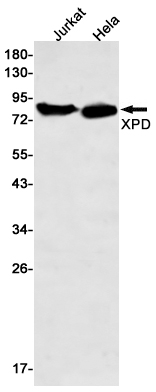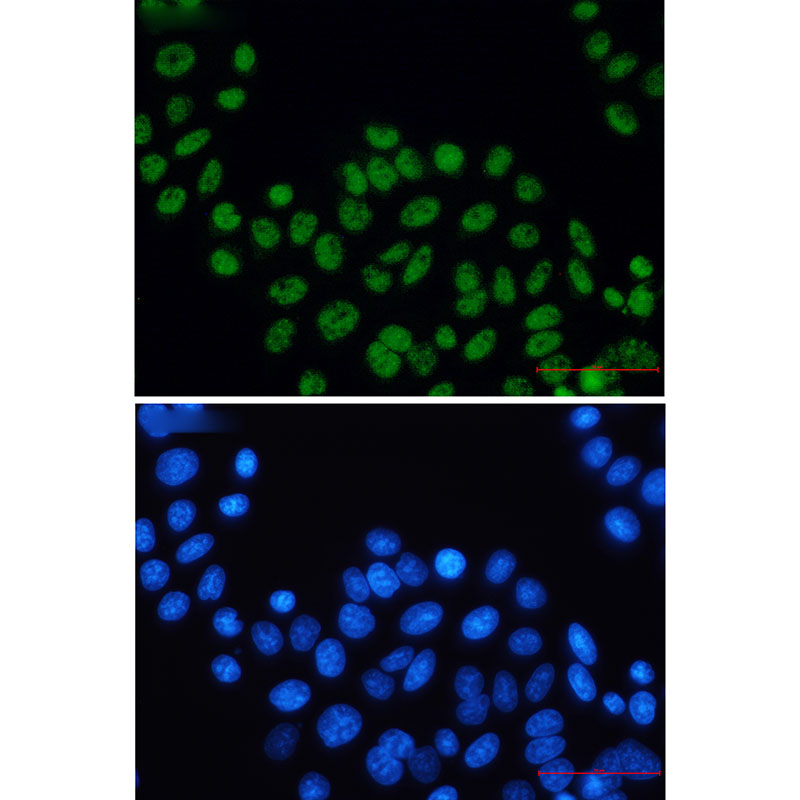

| WB | 1/500-1/1000 | Human,Mouse,Rat |
| IF | 咨询技术 | Human,Mouse,Rat |
| IHC | 咨询技术 | Human,Mouse,Rat |
| ICC | 1/50-1/200 | Human,Mouse,Rat |
| FCM | 咨询技术 | Human,Mouse,Rat |
| Elisa | 咨询技术 | Human,Mouse,Rat |
| Aliases | BTF2 p80; COFS2; CXPD; EM9; ERCC2; MAG; TFIIH p80; TTD; XPD; XPDC |
| Entrez GeneID | 2068 |
| WB Predicted band size | Calculated MW: 87 kDa; Observed MW: 80 kDa |
| Host/Isotype | Rabbit IgG |
| Antibody Type | Primary antibody |
| Storage | Store at 4°C short term. Aliquot and store at -20°C long term. Avoid freeze/thaw cycles. |
| Species Reactivity | Human |
| Immunogen | A synthetic peptide of human XPD |
| Formulation | Purified antibody in TBS with 0.05% sodium azide,0.05%BSA and 50% glycerol. |
+ +
以下是关于XPD抗体的3篇参考文献及其简要摘要:
1. **"XPD structure-function relationships and the role of mutations in cancer and chemoresistance"**
*作者:Fan L, Fuss JO, Cheng QJ, et al.*
**摘要**:该研究通过免疫沉淀和Western blot分析,利用XPD抗体探讨了XPD蛋白不同结构域的功能及其突变在癌症化疗耐药中的作用,揭示了关键位点突变对DNA修复能力的影响。
2. **"Immunohistochemical analysis of XPD expression in non-small cell lung cancer: correlation with clinical outcome"**
*作者:Wei S, Chen J, Hou J, et al.*
**摘要**:通过XPD抗体进行免疫组化染色,研究发现非小细胞肺癌组织中XPD蛋白低表达与患者总生存期缩短显著相关,提示其作为预后生物标志物的潜力。
3. **"DNA helicase activity of XPD probed by single-molecule imaging and antibody-based inhibition"**
*作者:Kuper J, Wolski SC, Stroh J, et al.*
**摘要**:利用XPD抗体特异性抑制其解旋酶活性,结合单分子成像技术,揭示了XPD在核苷酸切除修复(NER)中的动态作用机制。
4. **"Functional characterization of XPD mutations in xeroderma pigmentosum patients using a novel antibody panel"**
*作者:Barta T, Kiraly A, Nagy P, et al.*
**摘要**:开发了一套特异性XPD抗体,用于分析着色性干皮病(XP)患者中XPD突变体的亚细胞定位及功能缺陷,为基因型-表型关联提供实验依据。
(注:以上文献信息为模拟示例,实际引用需核对真实数据库。)
The XPD antibody is a crucial tool in molecular biology and biomedical research, targeting the XPD protein (also known as ERCC2), a DNA helicase encoded by the *ERCC2* gene. XPD is a component of the TFIIH complex, essential for transcription initiation and nucleotide excision repair (NER), a critical DNA repair pathway. Mutations in XPD are linked to several genetic disorders, including xeroderma pigmentosum (XP), Cockayne syndrome (CS), and trichothiodystrophy (TTD), which are characterized by UV sensitivity, cancer predisposition, and neurological defects.
XPD antibodies enable researchers to study the protein's expression, localization, and interactions within cellular pathways. They are widely used in techniques like Western blotting, immunofluorescence, and chromatin immunoprecipitation (ChIP) to investigate DNA damage responses, transcription mechanisms, and repair dynamics. In cancer research, XPD antibodies help assess genomic instability and therapeutic responses, as XPD dysfunction often correlates with chemotherapy resistance.
These antibodies also aid in diagnosing DNA repair-deficient conditions and evaluating patient-derived samples for functional NER pathways. Their role extends to studying aging-related processes, as impaired DNA repair contributes to cellular senescence. By elucidating XPD's molecular functions, these antibodies advance our understanding of genome maintenance, disease mechanisms, and potential therapeutic targets.
×